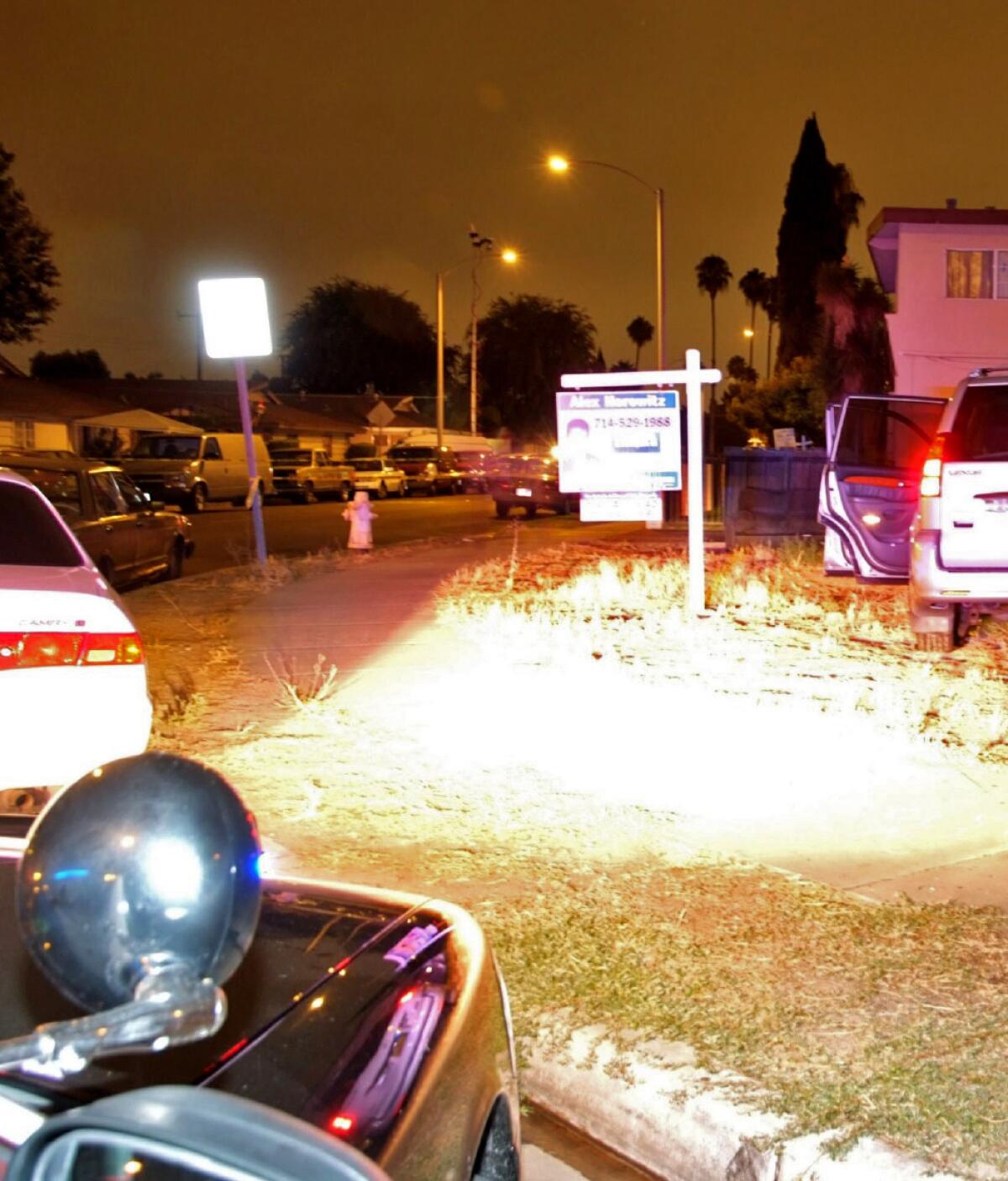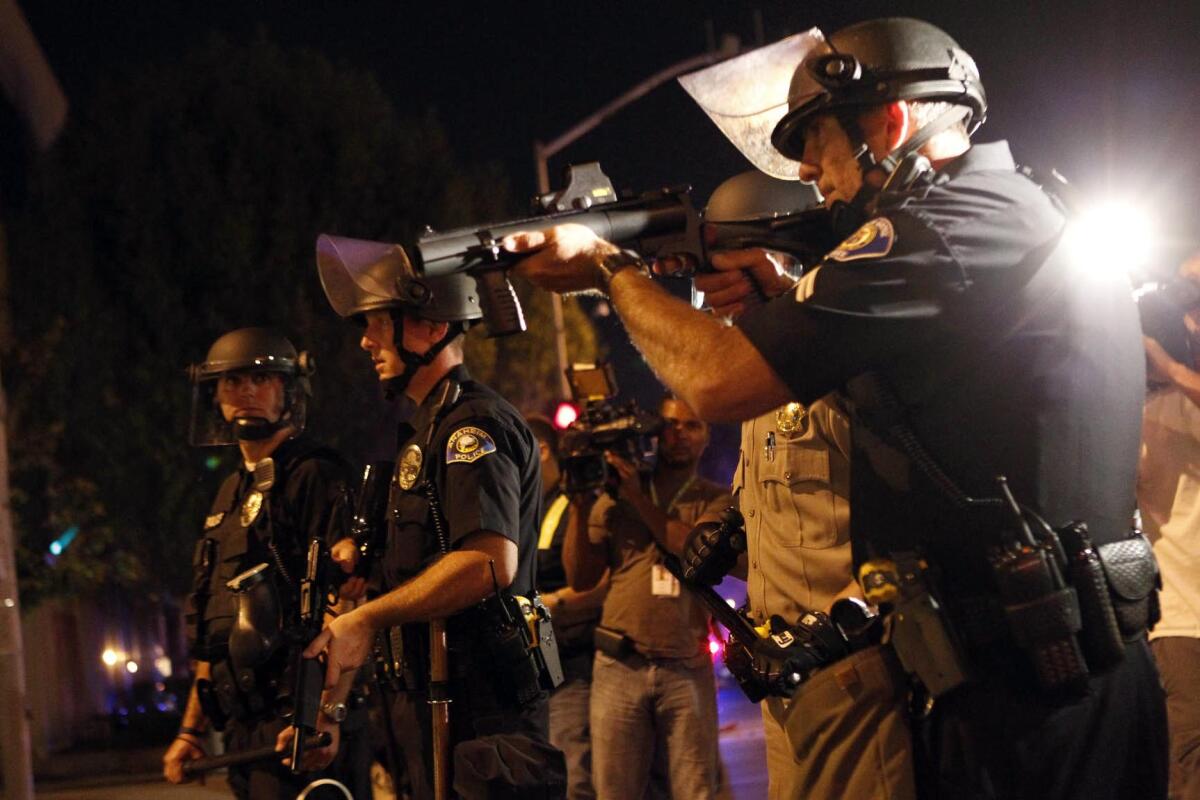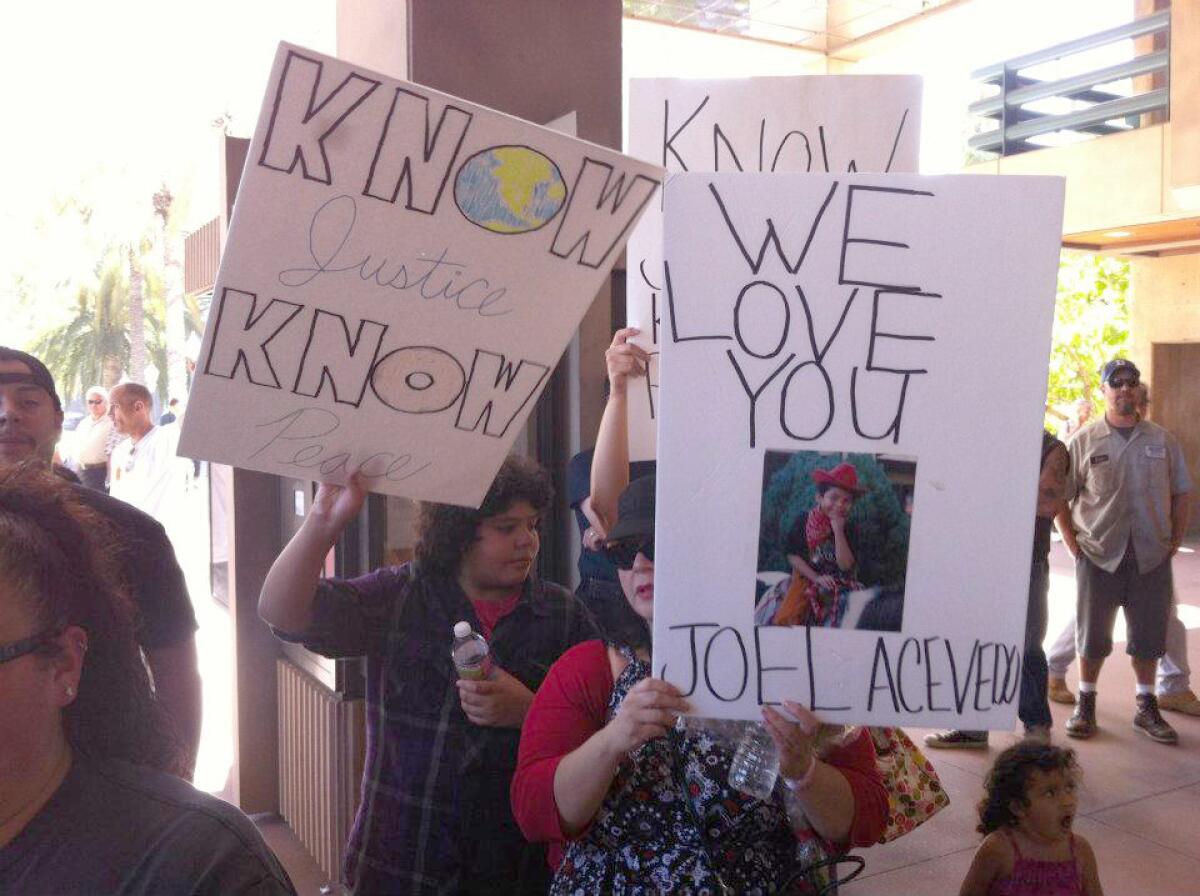Transparency law allows for a new look at police shooting 10 years after Anaheim Riots

At a conference room inside Anaheim Police Department, Donna Acevedo-Nelson recounted the last conversation she had with Joel Acevedo, her son, before an officer fatally shot him.
On July 22, 2012, Acevedo visited her to do laundry — a weekly routine — before she made him a sandwich for lunch as he passed the time listening to music on the computer.
“I’m always worried about you, especially after yesterday,” Acevedo-Nelson recalled saying in a recorded interview with an Orange County district attorney investigator.
The day before, Anaheim Police Officer Nick Bennallack shot and killed Manuel Diaz, a 25-year-old unarmed gang member, on Anna Drive. Residents gathered in the aftermath to protest the daylight killing.
Officers pelted them with projectiles after dodging bottles thrown from the crowd; a police K-9 ran into the melee and bit a young man. Hearing a volley of sirens nearby, Acevedo-Nelson didn’t know what happened at the time but worried about her son; she finally reached him by phone after calling several times.
Still distressed on Sunday morning after seeing the news, Acevedo-Nelson talked to her son about the police shooting.
“Do you know that guy?” she asked.
“Why would I know him?” he said. “I don’t hang around with people from over there.”
Acevedo-Nelson warned him not to run from police; before leaving, he told her not to worry and that he loved her.
Later that night, Acevedo bolted from a Lexus SUV after it crashed during a police pursuit on Guinida Lane, a working-class Latino neighborhood near Disneyland but tucked away from tourists’ eyes. Officer Kelly Phillips later told O.C. D.A. investigators that Acevedo shot at him first before he returned fire.
“We find that Officer Phillips’ claim of self-defense is credible and is strongly corroborated by physical evidence at the scene and other witness’s statements,” a D.A. investigation letter released in 2013 concluded.
By that time, the shooting had already fanned flames that erupted into a sizable downtown protest on July 24, 2012.
Ten years after the Anaheim Riots, once secret documents about the Acevedo shooting, now public under the release of records made possible by SB 1421, detail the backstory of how tensions building between a Latino neighborhood, a street gang and police turned into a maelstrom that shook the city to its core.

Weeks before Acevedo’s death, a Chevy Impala with tinted windows cruised the neighborhood around Guinida Lane amid a heated gang rivalry in Anaheim that already turned deadly.
Suddenly, a Corolla appeared and cornered the Impala; a brief standoff between the two cars ensued in the dark morning hours of June 1 until a gang member got out of the Corolla and opened fire.
The Impala, an undercover Anaheim police car, sped in reverse under a hail of bullets fired from a passenger in the pursuing Corolla. The two officers escaped the neighborhood with only two bullet holes in the front passenger side and no injuries.
Police later arrested a trio of 19-year-old gang members who faced numerous charges, with attempted murder of police officers the most serious among them.
Phillips felt it important for the D.A. investigator to know about the incident when he gave a voluntary statement eight days after the Acevedo shooting.
“We had two officers that were in an undercover car who were literally chased out of the neighborhood with gangsters shooting at them,” Phillips said. “It’s a pretty hostile neighborhood.”
Phillips also recounted anti-cop graffiti and alleged threats against Anaheim officers by gang members in the wake of an August 2011 police shooting of David Raya, an associate of Acevedo’s, who was unarmed when killed by Det. Bruce Linn on Guinida Lane.
With the controversial Diaz killing, Anaheim police buffed up patrols across the city. Phillips was set to work all week. Officers Daniel Lambaren and Trang Pham were temporarily assigned to boost gang suppression patrols; they rode with him in a marked gang unit police car on July 22.
Vanessa Duran headed out with Acevedo in the SUV that same night before stopping to pick up a friend who asked for a ride.
The two vehicles passed each other on Guinida Lane.
Phillips recognized Duran from a prior arrest. He checked his rear-view mirror and noticed the SUV didn’t have a license plate and began following Duran, who rolled through a stop sign before turning onto another street. The SUV soon sped away from the police lights flashing as it appeared headed back to Guinida Lane.
The SUV, which later turned out to be stolen, turned, jumped a curb and flattened its tires on an empty corner lot; all three occupants exited and fled down the street.
Phillips ended up trailing Acevedo into a nearby lot between two apartment buildings on Guinida Lane where he tried to find him behind parked cars. Gunshots rang out.
“I realize this isn’t a hide-and-seek game,” Phillips said. “He’s trying to kill me.”
The officer opened fire and struck Acevedo three times.
Phillips thought about first aid but didn’t want to send Pham back to their car after a shooting in the already-tense neighborhood. Instead, he approached the body and kicked a gun from Acevedo’s hand to remove any threat.
“I kinda regret it,” he told the D.A. investigator. “I kinda would like to have the gun in his hand when you guys got there so we get pictures of that.”

Anaheim police, D.A. investigators, Orange County Crime Laboratory scientists and paramedics arrived to the scene as a crowd of residents assembled. D.A. investigators paired with Anaheim police detectives on assignments, including Det. Linn who still remained under investigation for the Raya shooting, which was later deemed justified.
By then, Duran escaped into the night and stayed for a few weeks at a nearby motel.
In August, Anaheim police found and arrested her. The D.A.’s office offered to immunize Duran’s testimony about the Acevedo shooting from pending charges she faced.
Duran told a D.A. investigator in December that police chased and shot at Acevedo two days before his killing and that on the night of July 22, she witnessed his execution.
Hiding behind a dumpster and a tree near the scene, Duran claimed to have seen Phillips drag a wounded but still alive Acevedo back toward an empty parking spot that, ironically, belonged to her.
“He stomped on his chest and [Acevedo] started spitting blood out of his mouth,” she said.
Then, Duran said Phillips fired a single shot after Acevedo had been cuffed. Startled, she made a noise, gave up her position and dodged a policeman’s bullets as she fled.
Duran made similar claims in an unpublished 2013 interview with this reporter before she pled guilty. “They actually said that if I cooperated it would be better. But if they had to subpoena me ... and if I didn’t say anything, they could detain me for keeping info from them.”
But investigators didn’t find Duran’s account credible. No physical and forensic evidence collected from the scene corroborated its key claims. Neighbors interviewed only recalled hearing consecutive shots that night.
A crime lab forensic scientist concluded that three cartridge cases recovered near Acevedo’s body were fired from the handgun found between his legs. His DNA was also detected on the weapon. An autopsy report found no stippling or muzzle imprints consistent with close-range gunshot wounds.
Samples from Acevedo’s fingernails and knuckles were collected for a gunshot residue kit.
But it proved a formality. The crime lab stopped analyzing such kits in June 2009 after its forensic scientists kept being called to testify in court cases on whether they offered definitive proof.
“GSR kits tell us if a person was near or around a firearm, but they do not tell us whether that person discharged a firearm,” said Jaimee Blashaw, an O.C. sheriff’s department spokesperson.
According to the D.A.’s office, the gunshot residue test kit was destroyed in 2019.

No protests or vigils are set to publicly mark the 10th anniversary of the Anaheim riots.
The occasion arrives overshadowed by an ongoing FBI corruption probe into a self-described “cabal” of political operatives that caused Harry Sidhu, the city’s former mayor who served on council in 2012, to resign in May.
Genevieve Huizar, Diaz’s mother, died last year from COVID-19. Bennallack, who a jury found liable for excessive force in a civil trial, is no longer with Anaheim P.D.
Phillips received a distinguished service award from the department in 2014 and remains with the force as a sergeant.
“Our relationship with the community is strong,” says Sgt. Shane Carringer, an Anaheim P.D. spokesman. “We continue to seek opportunities to strengthen it further through the variety of programs the department has which encourage communication amongst police personnel and community members.”

Acevedo-Nelson has long felt that her son’s death was overlooked from that weekend of back-to-back police shootings a decade ago.
In 2014, she filed a lawsuit against Anaheim and its police department; two years later a federal judge dismissed the case, citing a lack of evidence for the plaintiffs’ “admittedly sparse tale.”
Duran was sentenced to a year in prison after agreeing a plea agreement in 2013. She admitted to unlawfully taking a vehicle, evading police while driving recklessly and doing so in association with a street gang.
D.A. investigators used Duran’s admission of guilt against the credibility of her immunized account.
An O.C. jury in the criminal trial of the three gang members who shot at an undercover cop car deadlocked on the attempted murder charges in 2015; an officer testified that she didn’t turn on identifying visor lights until late in the chase when they shined down on the passenger seat.
The three were convicted of firing on an occupied vehicle and sentenced to 15 years to life.
Overlooked or not, Acevedo’s death is interwoven into the tapestry of Anaheim’s history of police protests.
Acevedo-Nelson counted Theresa Smith as an early friend and even walked Caesar Cruz, her son, to class at the local elementary school on Guinida Lane decades ago.
Smith became a police accountability activist in 2009 when Cruz, 35, was slain by five Anaheim policemen, including Phillips, while unarmed.
In speaking with the D.A. investigator, Acevedo-Nelson cited a persistent fear for her own son’s safety.
“The same thing happened to someone that he grew up with last summer,” she said. “It happened to my friend’s son at the parking lot at Walmart.”
After the riots, Acevedo-Nelson joined Smith for weekly protests in front of the Anaheim Police Department.
All the latest on Orange County from Orange County.
Get our free TimesOC newsletter.
You may occasionally receive promotional content from the Daily Pilot.




